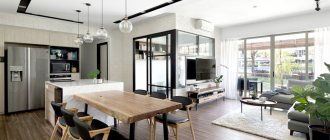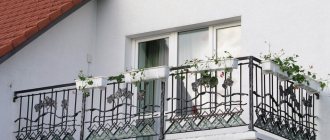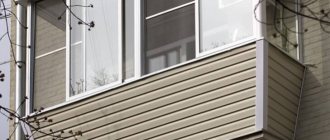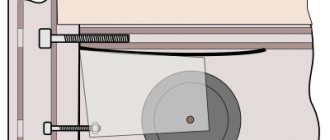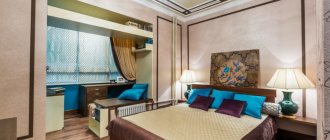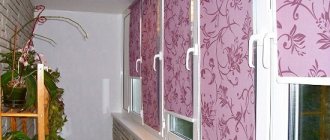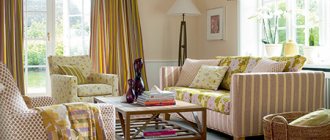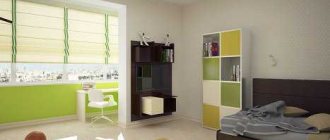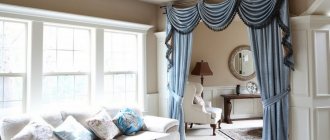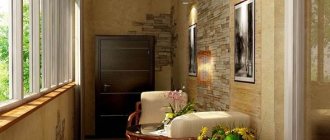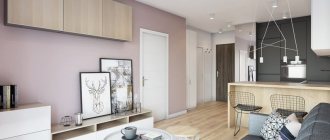Creating a comfortable zone on the balcony includes glazing. The construction area is usually relatively small, so there is a need for efficient use of space. Sliding windows onto the balcony help with this. They are made from different materials, differ in performance characteristics, but all are as convenient as possible when used in limited space.
Rice. 1 Option for sliding glazing of loggias
Choice of glazing technology
The very first question you need to ask yourself when choosing glazing is cold or warm? If the balcony is supposed to be used as an additional room, kitchen, etc., then warm glazing is necessary. If it is just a utility room, a simple cold one will suffice. And these two types differ in the number of cameras in the double-glazed window.
Cold glazing
This is the most inexpensive method, and besides, frames with such double-glazed windows will weigh relatively little, which makes it possible to place them on a slab with a small load capacity. These circumstances make such glazing of balconies quite popular. The low weight of the structure is explained by the fact that the double-glazed window installed here is a single-chamber one - this can be seen in the photo.
Glazing of balconies.
Photo of a single-chamber double-glazed window Important: cold glazing of balconies and loggias has one drawback - low, relative to warm glazing, sound insulation. So think about it: if your apartment is located next to a busy highway, maybe it’s worth investing in double glazing?
Warm glazing
Warm glazing of balconies is a more expensive technology than the cold option. However, this is fully justified by excellent heat and sound insulation. A balcony or loggia with warm double-glazed windows becomes suitable even for living in them - it is enough to install heating there for the winter period. And if they are combined with a room, then perhaps installing additional heating will not be necessary.
The heat and sound insulating qualities of winter glazing are ensured by the presence of two chambers in the double-glazed window - in the photo below there is an example of just this format. But do not forget that the more cameras, the greater the weight of the entire glazing. Therefore, before installing such double-glazed windows on the balcony, it is worth checking the condition of its supporting slab.
Warm glazing of balconies
Cost of sliding structures
The cost of sliding window designs varies greatly. Windows made of aluminum profiles are considered the most budget-friendly, and wooden ones are the most expensive. As for the type of design, there is no big difference in price between the parallel-sliding and rotary-sliding systems. In addition to these factors, the total cost of sliding windows consists of several components:
- glazing areas;
- thickness of glass, double glazing;
- quality of fittings;
- the presence of a mosquito net;
- additional functions;
- self-installation or with professional assistance.
The final cost will be formed only after the configuration has been clarified and calculations have been carried out.
Step-by-step technology for glazing a balcony with sliding aluminum structures:
PVC, aluminum or wood?
Now let's decide what kind of frames we need: PVC, aluminum or wood? They are all suitable for both warm and cold glazing, but the thermal performance indicators will be different for everyone.
Aluminum profile
Glazing of balconies with aluminum profiles has been gaining popularity in recent years. This is not surprising. This material is inexpensive, durable, resistant to thermal, chemical influences and ultraviolet radiation. It is possible to manufacture structures from aluminum to suit the most demanding requests - in color, shape and price. This is a good economical option.
Cold aluminum glazing of the balcony is excellent. The frame is light, thin, but at the same time quite durable. In the photo below - it’s a cold design - the frame itself consists of one chamber. If the load-bearing capacity of the load-bearing slab of your balcony is not high, or the glazing is carried out, then aluminum will be a good solution.
And now about the disadvantages of this profile:
- Low thermal protection compared to other materials.
- Possibility of frosting of the door opening mechanism in winter.
- Low sound insulation in some cases, for example, in sliding structures.
Glazing of balconies with aluminum: frame without decorative coating
PVC structures
Glazing of balconies with plastic windows has been known to Russians for a long time and has become commonplace, but is not losing its position in the market. This is due to the fact that PVC windows have several important qualities:
- Good thermal insulation qualities.
- High noise protection.
- Light weight. Warm glazing made of plastic will weigh less than a similar one made of wood or metal-plastic.
If we talk about the minuses, there are only two of them:
- A cracked or deeply scratched plastic frame cannot be repaired and will have to be replaced. But aluminum, for example, is not subject to cracks.
- When burned, plastic releases toxic gases. Wooden frames, which we will discuss below, are safer in this regard.
Plastic balconies: cross-sectional photo of the frame
Wooden frames
Many people consider glazing balconies with wooden frames to be archaic and outdated. And in vain, because wood is an environmentally friendly material that retains heat well. Another point that not everyone knows about: the glazing of balconies with wood is chamber-like, just like when using plastic or aluminum. In addition, wood, unlike plastic, is less susceptible to temperature fluctuations.
Wooden frames can be used on balconies and loggias of any type, if there are no weight restrictions. With proper care, the structure will last quite a long time, although less than those mentioned above. There are only two disadvantages to wooden frames, one of them is controversial: wood is inferior to plastic in terms of tightness. And this minus is controversial because the complete tightness of PVC sometimes leads to fogging of the glass and high humidity in the room, which happens less often with wood. The second disadvantage is the need for constant monitoring of the paintwork from the inside and outside.
This is what a wooden frame looks like in section
Features of installing sliding structures
All sliding windows have a similar design, consisting of a profile, glass unit, fittings and additional parts. The process of installing sliding systems goes through several stages, but depending on the type of structure and material, there are specific features of installing sliding window systems. In general, window installation looks like this:
- Preparing the support for the frame . The main requirement is a flat and durable support surface on which the window frame will be installed. In the case of a “warm” finish, a supporting wall of foam concrete blocks is installed, which is carefully sealed on the sides and at the base. A layer of cement mortar is laid on top of the supporting wall and balcony railing and carefully leveled, which will serve as a support for the balcony frame. In some cases, it is possible to install additional support in the form of a wooden block or metal profiles.
- Frame assembly. This step is necessary in the case of aluminum profile windows. The frame parts are numbered and assembled using screws in accordance with the instructions. Sliding plastic windows for balconies are supplied assembled.
- Installation of window sill and ebb. The window sill can be solid or consist of several parts. It is screwed to the support. The drip is necessary to remove moisture from the frame to which it is attached. Silicone is used to ensure tightness. When installing aluminum structures, this stage is one of the last.
- Frame installation. Before installing the frame on the loggia, temporary fixation is required using perforated tape. If sliding glazing of balconies is performed, then this stage is absent. Plastic or wooden wedges will help you achieve a level horizontal surface. Anchor plates are installed on the top and sides of the frame for fastening to the wall surface and the top of the opening. The lower part of the frame is attached to the subframe. For glazing in several designs, the frames are fastened together using self-tapping screws or an additional profile with double-sided latches.
- Installation of the visor. If the canopy is installed on a balcony, then it is mounted on top of the subframe, and if on a loggia, then to the top of the frame.
- Sealing. After the sliding frames have been installed, it is necessary to seal all cracks and joints with foam or silicone sealant.
- Installation of sashes and installation of limiters. At the last stage, the sliding sashes are installed first in the upper part of the frame, and then in the lower part. To protect the moving sashes from damage, limiters are installed at the ends. They are attached using self-tapping screws.
- Checking the system operation. The final stage will be checking the functionality of the system: the absence of distortions, the ease of movement of the doors, the reliability of the latches - everything that allows you to protect the room from adverse external influences or the penetration of strangers.
Types of structures used for glazing
By choosing the type of double-glazed windows and material for the frames, you will have to decide whether you will install a sliding structure or a hinged one. Let's see what they are.
Sliding frames
First of all, it is necessary to note the ease of using them on small balconies. Hinged frames, familiar to all of us, when open, albeit a little, “eat up” space. If the width of your balcony is 80 cm, then a sash protruding even 20 cm will cause a noticeable inconvenience. Therefore, “sliding” balconies sometimes become a salvation.
The sliding system is quite reliable; for example, there will be no sagging of the frames, as in the swing version. Problems can only arise in cold weather: when ice freezes on the runners, the movement of the shutters can be difficult. But to avoid this, it is enough to take care of the canopy over the balcony and try not to open the windows during snowfall. Another drawback is that sliding structures today are made mostly of aluminum, they can be cold because of this.
How to glaze a balcony: sliding design
Swing frames
The swing mechanism is familiar to us all and is more familiar than the sliding-sliding mechanism. Previously, these were simple frames on two hinges, opening in one plane. Today the device has become more complicated, and in addition to ordinary plowing, we also have access to the so-called “slit ventilation” - you see it on the right side of the picture.
Hinged windows close tighter than sliding windows and are therefore more energy efficient. They are the best choice for warm glazing. The safety of the swing structure should not be ignored. Such windows are quite difficult to break open from the outside, while sliding windows can sometimes simply be pushed inward. This is worth paying attention to for those who live on the first floors.
Important: do not leave swing frames in the “slot ventilation” position unattended if there are cats in the house. The animal may try to exit through the gap and will most likely get stuck. Being in a pinched position for several hours can be critical for the body.
Wooden frame with swing opening mechanism
Finnish glazing
The system is similar to sliding glazing, since the sashes also move on runners. But with a sliding door we open only one door at a time, while the Finnish system allows you to open several at once. Thus, up to 80% of the entire opening can be opened. In addition, the profile for the Finnish system is thin, so the design is only suitable for cold glazing of balconies.
Loggia with Finnish glazing
Frameless system
Frameless glazing of balconies is often confused with Finnish. In fact, the similarity is only external; the system for opening and closing the doors is completely different; in terms of functionality, it is closer to a hinged door. The frameless design looks very modern and unusual. True, frameless glazing has a significant disadvantage for our strip - it does not protect the room from the cold at all. If you are interested in how to do frameless glazing of balconies with your own hands, the video can be found on the Internet.
Frameless glazing system
Windows to the loggia
Today there are many options for glazing a loggia. The structures are made from different materials and have different characteristics. Each option has its pros and cons.
Peculiarities
A loggia is a great way to increase the living space in an apartment. It can be converted into a full-fledged room. It can become a wonderful office, small gym, creative studio, dining area or relaxation area.
Many owners of large and small apartments are turning to similar solutions today. Some people continue to use the loggia as a large storage room, but with finishing and neat repairs.
To design a beautiful and functional loggia, it is necessary to carry out several stages of work. These include insulation and finishing (both external and internal). Glazing plays one of the main roles.
This point should be treated very responsibly, since the comfortable characteristics of the space being repaired will depend on the choice of glazing. Today there are several types of glazing. Some options are designed to maintain warmth and comfort, while others are designed only to protect the space from the negative influences of the external environment (rain, snow, wind).
The correct choice of glazing directly depends on the location of the apartment and the design of the entire house. For a small "Khrushchev" you should not choose glazing with heavy double-glazed windows and plastic frames. On the loggia you can install not only classic windows with frames in a row, but also luxurious panoramic or stained glass.
They will look especially impressive in spacious loggias on the upper floors.
You can install glazing on the loggia yourself. To do this, you should follow simple instructions and carry out the work step by step. If you doubt your strengths and skills, then it is better to entrust this process to professionals.
Types of windows, their pros and cons
Today there are several types of windows. It is worth considering them in more detail.
Plastic
The most common and in demand are plastic windows. They have been in great demand for many years and are unlikely to lose their relevance. This popularity is due to the wear resistance and durability of such structures. They do not lose their original appearance and perfectly protect against adverse weather conditions.
Plastic windows look very neat and aesthetically pleasing. They easily fit into many interiors of different styles. They can confidently be called universal. It is impossible not to note the affordable cost of such glazing. It will cost buyers less than, for example, windows with wooden frames.
Plastic structures are much easier to install. Today there are a lot of specialists on this issue. However, if you want to do the installation yourself, then this is quite possible.
The disadvantage of plastic double-glazed windows is their heavy weight. Because of this characteristic, they are not suitable for installation in the loggias of old houses. This can have a negative impact on the walls and lower floors.
Wooden
Wooden windows for loggias and balconies have been very popular lately. They look very expensive and attract the attention of passersby. It is worth noting the environmental friendliness of such parts. They are absolutely safe for the health of the whole family.
If you decide to add such glazing to your loggia, then you should know that wooden frames require special care. They must be treated with antiseptic agents and their condition monitored. Often you have to resort to varnish coatings for wood.
Even proper and regular maintenance does not guarantee the preservation of the original appearance of such frames. After some time, they will begin to dry out, which will lead to the appearance of cracks.
Such structures are more expensive than plastic ones, but their appearance and environmental friendliness fully justify the high cost.
Aluminum
Aluminum double-glazed windows are in enviable demand. They are lightweight and easy to install. It is impossible not to note the durability of such structures. This characteristic is explained by the high strength of the material and its wear resistance.
The disadvantage of this design is that it is more suitable for cold glazing. Aluminum structures are very rarely used for warm glazing, and therefore are cold. If the weather is frosty outside and your windows are sliding, the mechanisms may freeze. This drawback is observed by many owners of similar glazing on the loggia.
Types of glazing
There are two types of glazing:
- Cold glazing. First of all, it is aimed at protecting the loggia from negative influences from the outside. However, it is not able to maintain room temperature when it is cold outside. It will not be able to protect cold glazing from heat in the summer season. This option is not the most successful for decorating a loggia as a full-fledged room.
- To create a warm and cozy environment, warm glazing is ideal. For this type, plastic windows with double-glazed windows are most often used. These structures perfectly protect the loggia from dampness and moisture. They have excellent thermal insulation properties.
If you prefer warm glazing, then the loggia can be used all year round, as it will always be comfortable.
Windows differ from each other in their opening/closing methods. The most popular design is the hinged one, followed by the sliding one. Hinged sashes are attached to the profiles with hinges, and sliding sashes operate using a special roller system.
According to its external design, glazing can be panoramic, stained glass, classic and frameless:
- One of the most popular recently is panoramic glass. As a rule, they are large in size and look very expensive.
They are recommended for people living in beautiful places or on upper floors.
- Classic double-glazed windows with frames will never lose their relevance. As a rule, they are equipped with hinged doors.
- Stained glass windows look original and interesting . When choosing these options, it is recommended to stock up on blinds to slightly cover the loggia. The same applies to panoramic windows.
Tips for choosing
If you seriously decide to refurbish your loggia and turn it into a full-fledged room, then you should turn to warm glazing. It will protect the room from cold and adverse weather conditions. Many people additionally insulate such rooms using underfloor heating systems or portable heaters.
If you are not going to spend a lot of time on the loggia, you don’t need it all year round, then you can get by with cheaper cold glazing.
You can highlight your home and make it truly chic with the help of stained glass, frameless or panoramic windows. They are able to effectively illuminate living spaces and visually make them more spacious.
However, do not forget that they make the loggia too open. Passers-by will be able to see everything that happens on it, so it’s worth purchasing blinds.
Choose high quality glazing. Pay attention to all materials and serviceability of fittings. If window handles stick, click loudly, or are difficult to turn, this may indicate poor quality. In the near future they will have to be replaced with new ones.
Installation stages
It is worth considering the stages of glazing installation using the example of plastic windows:
- First you need to take all the dimensions: the length and width of the window opening. Try not to make mistakes, as all readings must be as accurate and correct as possible.
- After this, you need to decide on the mechanisms of operation of the valves . Companies producing plastic windows most often offer the most common options for loggias with an area of 3 m and 6 m. Immediately calculate the required number of window sills, profiles and other parts.
- The old glazing (if any) must be removed. Do this carefully so as not to damage the wall. First you need to get the glass, and then the frames. They can be sawed to facilitate dismantling. Pay attention to the condition of the wall under the window. If it requires repairs, then these shortcomings should be eliminated and the foundation strengthened.
If the loggia is 3 m, then, as a rule, it is solid. It is raised and leveled. During this time, double-glazed windows must be removed from their frames.
- After this, you need to attach the frames to the walls with pre-prepared holes. A visor is attached to the top. Six-meter frames are most often divided into several sections, which is why they are installed in several stages. This method is more complex and time-consuming. During the process, it is necessary to constantly monitor the horizontal and vertical levels.
- Double-glazed windows can only be inserted after the frames have been completely installed. Then you need to attach the window sill. This can be done using polyurethane foam. It must be adjusted to size in advance and the excess must be sawed off. Be sure to put caps on the edges.
All cracks must be treated with polyurethane foam.
- Accessories. It is installed at the very end (handles, plugs, mesh).
A more detailed process of installing plastic windows on a loggia can be seen in the following video.
Examples in the interior
It is worth taking a closer look at several harmonious design designs of loggias:
- The six-meter loggia can be decorated with sliding plastic windows. The interior should be complemented with a compact cream sofa, a small window-sill table and bar stools. You can put carpet or laminate on the floor, and decorate the walls with decorative plaster.
About the legal side of the issue
Balcony glazing, primary or simply replacing old glazing with new one, requires documentation. Of course, you can, for example, glaze a balcony in a Khrushchev-era building without decorating it. But this turns out to be a kind of “powder keg”. One statement per live. inspection from a “caring” neighbor, and you may get some problems.
We prepare documents
In general, the requirements for paperwork may differ in different regions, so before getting started, it is better to find out what will be correct for your city. Basic instructions for collecting the necessary papers are also given here.
- From the company that will work on your balcony, take a project drawing of the future glazing. With this sheet you go to the BTI, they must issue a conclusion indicating that work on this project is possible.
- Now the Architectural and Planning Department. This organization must approve changes to the facade of the house. The APU may not be satisfied with the material you have chosen for the outer cladding. In this case, be prepared for the fact that the project will have to be redone. Also, the APU may not “like” remote glazing.
- Next we go to ROGPN - in other words, fire supervision. They must evaluate how well the structure you are going to build complies with fire safety standards.
- SES – does the premises comply with sanitary standards and functional purpose.
- DEZ - here you need to obtain a document confirming that your design will not interfere with the current operation of the house.
- District vein. Inspection. We go there with all the papers received from the above organizations. It may be necessary to carry out an examination of the project, since it was carried out by a private owner, to confirm compliance with SNiP and operational standards.
- The last authority is the MVK, here you will receive permission to begin work legally. By the way, MVK has simplified the issuance of glazing permits for houses of the following series: P55M, P44T, P3M, P46M and Pd4.
If such trips to authorities are not to your taste, or you simply do not have enough free time, then you can contact a company that provides paperwork services.
Maintenance of sliding structures
One of the advantages of sliding window systems is their long service life, from 20 to 50 years. In order for windows to last their intended period, they must be properly used and properly cared for. For easy operation of mechanical elements, it is necessary to lubricate each mechanism once every 2-3 years.
All cavities, guides, and rubber seals should be cleaned. To do this, you will need to remove the doors and clean them with a vacuum cleaner. Brush seals on aluminum windows require annual cleaning. In winter, during severe frosts, if the sashes freeze, you can use a special defroster or wait for warmer weather.
